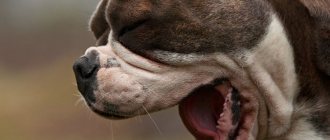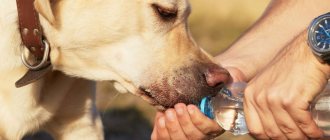The article was finalized and certified
Dubovitsky Yuri Igorevich
Veterinarian
Ask a Question
A healthy dog at rest has smooth and almost silent breathing. The number of breaths per minute ranges from 10 to 30 times (and 12-14 at rest). At the same time, small breed dogs breathe more often than large dogs; the breathing rate of females is higher than that of males, and that of puppies is higher than that of older pets. Any breathing problems, for example, wheezing during inhalations, is a reason to contact a veterinary clinic. In this article we will try to figure out why a dog is breathing heavily.
Causes of heavy breathing
In a normal physiological state, dogs breathe exactly at a rate of 12-30 movements per minute. The smaller the breed, the more frequently the dog will breathe. The rate of breathing can change during physical activity or stress. In a number of physiological conditions (pregnancy, excitement, feeding), the rhythm may increase. But all these changes cannot be called heavy breathing in a dog, since they do not last long and have a compensatory function that does not exceed the physical capabilities of the animal.
It’s another matter when the dog’s body experiences difficulty breathing. This happens due to a variety of reasons:
- heat stroke, which occurs when a dog overheats in the warm season (especially common since there are no sweat glands);
- heart failure, common in older dogs;
- infectious pathologies are accompanied by inhibition of all body functions;
- intoxication – chocolate and alcohol are dangerous for dogs;
- pain reaction;
- hypoglycemia due to metabolic disorders;
- state of shock with serious injuries, large blood loss.
Rare deep breathing is characteristic of the near-death state. In dogs, there is a long period of apnea, followed by a convulsive strong breath. The rhythm is usually disturbed, the intervals between breaths are uneven.
Determining the cause of heavy breathing is necessary to fully treat the animal. But before starting a clinical and instrumental examination, the dog’s condition should be brought back to normal. Emergency care is aimed at restoring blood volume, body temperature and, most importantly, respiratory function.
Why does it happen that a dog breathes quickly?
It has been established that in a calm state, our four-legged friends usually take 10-30 breaths per minute. But this value is conditional and depends on the size of the dog and its age. The breathing rhythm changes after significant physical activity, during long running, etc. This is especially typical for the hot season, when the frequency of breaths per minute can reach 160. The pet’s breathing will become faster due to overexcitement. The breathing rate is different and the animals are restless and have an unstable nervous system.
These are all normal physiological phenomena. But when rapid breathing occurs with minimal activity or even at rest, one should already think about pathology. In this case, it is useful to observe the animal. In a calm environment, the dog does not open its mouth when breathing and does not make any noise (of course, in the absence of a special structure of the muzzle, for example, like pugs, then the pets not only sniffle, but also snore). There can be many reasons why a dog is breathing rapidly:
- cardiac pathologies;
- pulmonary diseases;
- unhealthy pulse;
- neoplasms in the respiratory tract or lungs;
- pneumonia due to an infectious lesion of the body;
- obstruction of the respiratory tract;
- injury accompanied by bleeding into the chest or accumulation of fluid in it, etc.
When your pet begins to breathe faster for no good reason, it means that he should be taken to the veterinary clinic. After all, this already predominantly indicates the presence of a pathological condition, which must be identified in order to provide qualified assistance.
Diagnostic methods
To assess the animal's condition, the respiratory rate should be measured. The rhythm of the movement is noted, and it is important to determine what type of breathing is used - chest, abdominal or mixed. The abdominal type of breathing is not typical for dogs and occurs with serious pathological disorders of the respiratory organs - pneumothorax, hydrothorax.
A sick animal shakes, stretches its neck and head. In a serious condition, he lies or stands with his limbs apart. Breathing is wheezing through the mouth with increased work of the abdominal muscles. General state of anxiety, only in stupor there is no reactivity.
Differential diagnosis:
- with hyperthermia (heat and sunstroke), convulsions, increased salivation, tremors, and coma appear;
- heart failure is accompanied by a drop in blood pressure, arrhythmia, and tremors;
- bacterial and viral pathologies are characterized by an increase in temperature by 1.5-3 degrees above normal, damage to the respiratory and digestive systems;
- intoxication is accompanied by vomiting and diarrhea;
- In case of injuries in dogs, severe pain reaction, bleeding, damage to the integument, bones, and internal organs are noted.
Snoring and whistling sounds during inhalation occur with spasm and blockage of the upper respiratory tract. A similar pathology of the lower respiratory tract is characterized by wheezing on exhalation. If the lung tissue is damaged (pneumonia, edema), wheezing, squelching sounds are detected by auscultation.
If the dog is breathing heavily and frequently with wheezing, external respiratory function should be assessed. To determine this parameter, a blood gas analysis is required. There are several technologies. Pulse oximetry measures hemoglobin levels, which indirectly indicates the oxygen content in arterial blood.
Capnography works on a completely different principle. In this case, the air exhaled by the dog is analyzed, in which the concentration of carbon dioxide is determined. The measurement is taken after intubation and is the most accurate way to accurately assess a dog's respiratory function.
Emergency help for rapid breathing
But it happens that the pet’s condition worsens, and it is not possible to transport it immediately to a veterinary clinic. Then the owner himself should provide first aid. First of all, the animal should be given complete rest. Place it in a separate room or in a quiet, cool corner. Try to ventilate the room to ensure a flow of fresh air.
But at the same time, there is no need to force him to settle, nor do you need to force him to drink a lot. After all, you can only make the situation worse. Having created such conditions, you need to take care to call a veterinarian at home. And before he arrives, you should under no circumstances give your pet any medications. After all, this can only complicate the further process of therapy.
But it’s best to try to deliver the dog to the clinic yourself, in order not to waste precious time. Here, different treatment methods will be used to make an accurate diagnosis, and there is everything to take urgent measures if something happens. So, a special mask is used to saturate the dog’s body with oxygen. And if such a measure does not have the desired effect, surgical intervention may be performed.
Principles of emergency and therapeutic care
Quickly assessing the animal's condition, stabilizing it and returning it to normal is the key to successfully treating panting. Depending on the lesion, treatment can be medicinal (bronchodilators, corticosteroids) or surgical (tracheostomy, tracheotomy, thoracentesis). In most cases, oxygen therapy is necessary - artificial ventilation is performed during diagnostic and therapeutic measures.
Emergency help:
- determination of respiratory rate - if it decreases, intubation is carried out with the introduction of oxygen;
- rapid breathing, accompanied by whistling sounds and severe depression, indicates obstruction of the respiratory tract - it is necessary to administer corticosteroids and anesthesia;
- surgical intervention is performed to eliminate the cause of the obstruction;
- removal of foreign bodies is carried out under general anesthesia;
- if accumulation of fluid and gases in the chest cavity is suspected, thoracentesis is performed;
- After stabilization of the serious condition, the examination of the animal is completed.
Most often, heavy breathing is observed before the death of an animal. This is a dangerous pathological sign that indicates serious negative changes in the dog’s body. Therefore, it is so important to quickly help the animal, even without making a full diagnosis. Compensation of vital functions in this case is a more necessary step than treatment of the etiological factor.
After eliminating the threat to the dog’s life, you can resort to treatment for the underlying disease. Antibiotics, sulfa drugs, interferon, and immunoglobulins are prescribed to increase resistance and suppress infections. Novocaine blockades with the addition of antibiotics have a great positive effect - they block the stellate ganglion and suprapleural nerve nodes. This allows you to stop the pain reaction and suppress the microflora.
They stop the dog’s pain reaction and lower the temperature. For this purpose, analgin and baralgin are used. Eliminate bronchospasms using bronchodilators. Expectorants are used together with them. Antihistamines are indicated to avoid complications in the dog.
Breathing characteristics of some breeds
In representatives of some breeds, rapid breathing can be considered the norm, and not a pathology, and this is due to the anatomical features of the animals. They have an increased pulse, and shortness of breath is associated with the special shape of the skull - a shortened muzzle, narrowed nostrils, and a short soft palate. Such breeds are called brachycephalic. They suffer from infectious and colds more often than other dogs.
Typical representatives of brachycephals are Pekingese and Pugs. It seems that they are constantly wheezing, wheezing, and snoring in their sleep. In fact, it is difficult for them to draw air through their nose. Anatomy also explains the fact that brachycephals quickly overheat, so they often stick out their tongues in an attempt to cool down.
Spitz dogs have a special structure of the larynx, so during illness, as well as in stressful situations, they experience the so-called “reverse sneezing syndrome,” which resembles a cough and increases the respiratory rate.
Features of the prevention of respiratory pathologies
A variety of reasons can lead to heavy breathing in a dog, so preventive measures come down to maintaining health and a high level of resistance in the animal.
The first thing to pay attention to is feeding your pet. A complete diet provides your dog with proteins, fats, carbohydrates, vitamins and minerals. This is the main component of the formation of immunity. The level of feeding is affected by the breed, age, sex and weight of the animal. You should not overfeed your pet, as this also negatively affects metabolism and undermines resistance.
In terms of maintenance, guard dogs suffer more than others. Cold in winter, high humidity in autumn and drafts are the main predisposing factors in the development of respiratory pathologies. In the summer, dogs kept outside often suffer from heatstroke. Therefore, you should provide the dog with a booth that protects it from all weather conditions.
Infectious agents also cause damage to the respiratory system. Pathologies of other systems also lead to heavy breathing. Regular vaccination, early diagnosis and treatment will help avoid complications in dogs. To maintain health, dogs need to be dewormed. But it is important not to forget that the thoughtless use of veterinary drugs leads to intoxication and allergic reactions, which are also included in the etiological factors of difficulty breathing.
Symptoms of rapid breathing and heartbeat
With rapid breathing caused by malaise, changes in the animal's behavior are immediately noticeable. It can be:
- restless behavior, trembling;
- cough, shortness of breath, hoarseness;
- blue gums;
- reluctance to eat;
- vomiting, diarrhea.
Moreover, if the dog has rapid breathing and heartbeat, as well as trembling, it is almost impossible not to see all this. When a pet exhibits disorientation, it is most likely to suffer from heatstroke. He should be placed in a cool place, given a drink, and a wet towel applied to his head.
A bluish tint to the tongue and fainting can occur with heart problems. In this case, the animal should be well covered, warm heating pads should be applied to its paws, a veterinarian should be called to the house, and before his arrival, Cordiamine should be administered intramuscularly. But the presence of a whole set of the above symptoms should be a particular cause for concern. In this case, a visit to an experienced veterinarian is mandatory, because this is exactly the case when, as they say, delay is like death.











